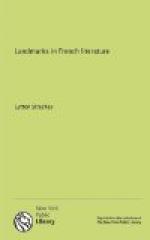Saint-Simon’s style is the precise counterpart of his matter. It is coloured and vital to the highest degree. It is the style of a writer who does not care how many solecisms he commits—how disordered his sentences may be, how incorrect his grammar, how forced or undignified his expressions—so long as he can put on to paper in black and white the passionate vision that is in his mind. The result is something unique in French literature. If Saint-Simon had tried to write with academic correctness—and even if he had succeeded—he certainly would have spoilt his book. Fortunately, academic correctness did not interest him, while the exact delineament of his observations did. He is not afraid of using colloquialisms which every critic of the time would have shuddered at, and which, by their raciness and flavour, add enormously to his effects. His writing is also extremely metaphorical; technical terms are thrown in helter-skelter whenever the meaning would benefit; and the boldest constructions at every turn are suddenly brought into being. In describing the subtle spiritual sympathy which existed between Fenelon and Madame de Guyon he strikes out the unforgettable phrase—’leur sublime s’amalgama’, which in its compression, its singularity, its vividness, reminds one rather of an English Elizabethan than a French writer of the eighteenth century. The vast movement of his sentences is particularly characteristic. Clause follows clause, image is piled upon image, the words hurry out upon one another’s heels in clusters, until the construction melts away under the burning pressure of the excitement, to reform as best it may while the agitated period still expands in endless ramifications. His book is like a tropical forest—luxuriant, bewildering, enormous—with the gayest humming-birds among the branches, and the vilest monsters in the entangled grass.




